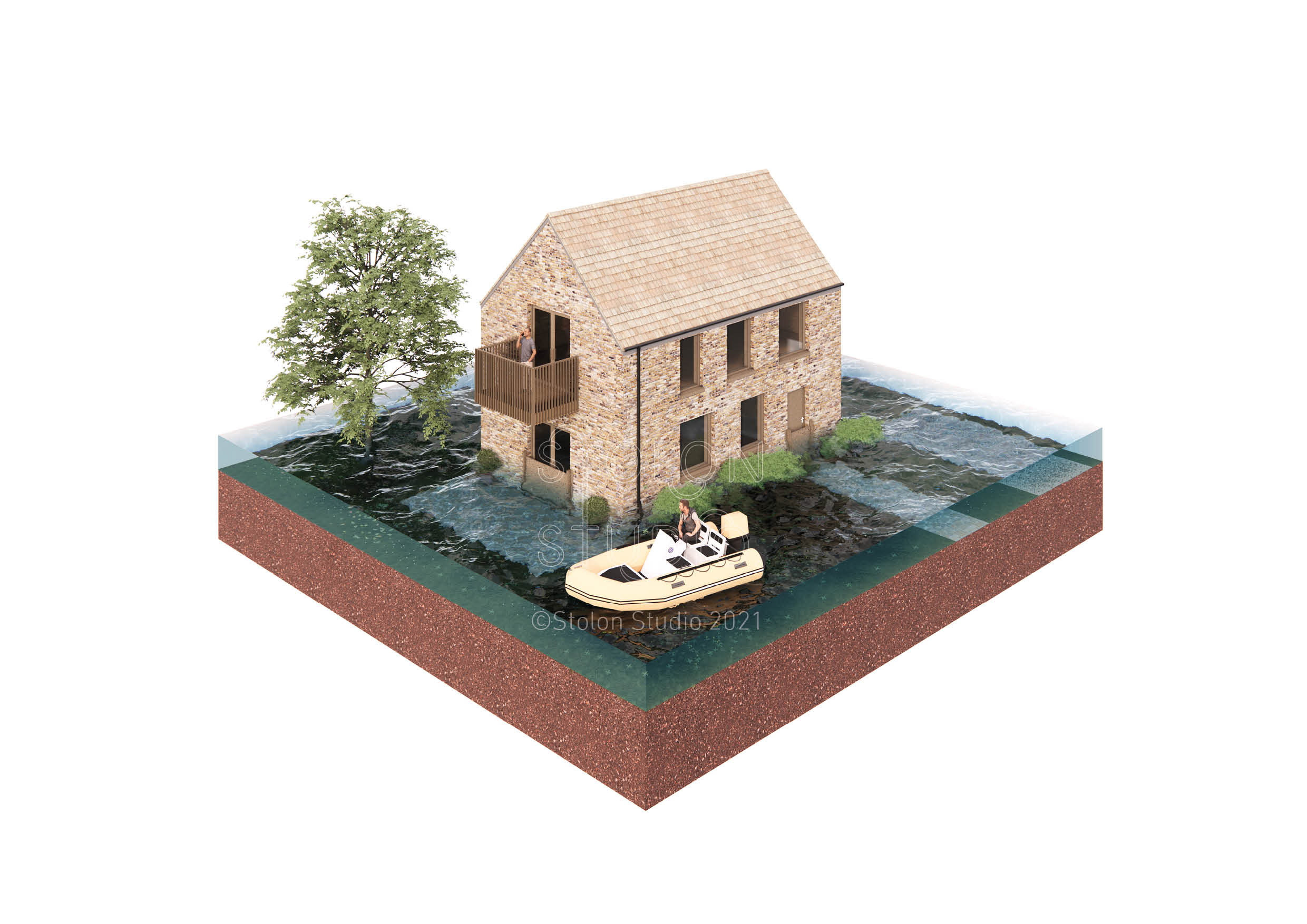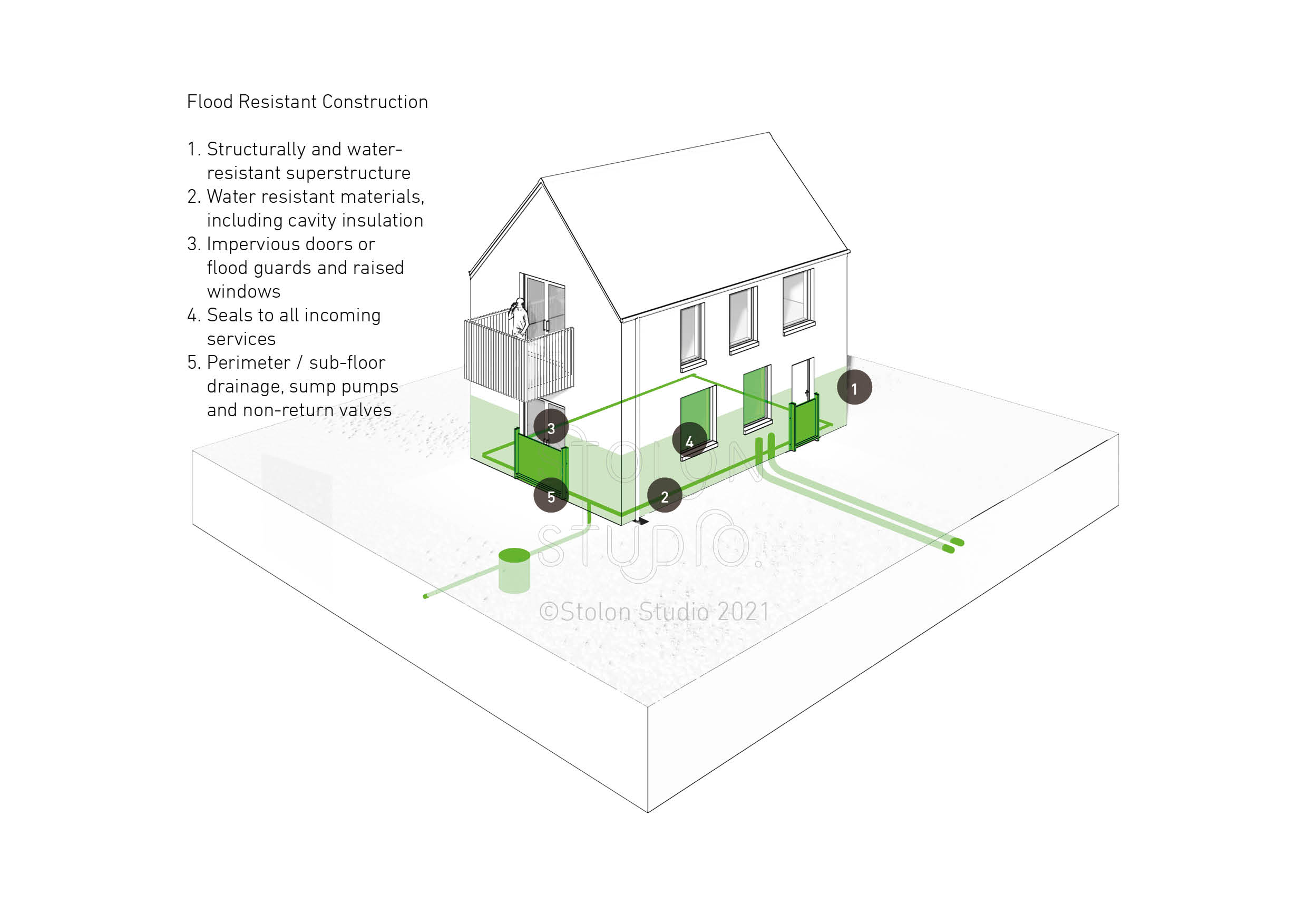Flood Resistant Construction
A flood resistant building is one that is designed to resist flood water ingress. That means that the building is designed to prevent flood water from entering through the walls, floor and any apertures. The deeper the flood water and the higher the velocity, the more difficult it is to keep water out. As water rises on the outside of the building it creates a force on the ground floor and outside walls including any windows and doors at that level.
Flood resistant buildings are typically constructed using concrete or steel and concrete but may also be made with masonry provided there is an impervious layer, such as water-resistant render or asphalt. Typically, frame buildings are more difficult to make flood resistant without a concrete or masonry layer due to the number of potential pathways for water around junctions. Masonry is generally permeable, as is concrete unless to a certain specification. Therefore, water can seep through walls and floors unless designed properly. Cavity walls may need to be filled with water resistant insulation below the flood level to prevent the passage of water and to prevent contamination within the cavity.
The ground floor is a potential pathway for floodwater to enter, particularly if flood water remains present outside for a period of time. This is because the water will seek to reach an equilibrium inside and outside the building. If the pressure from the rising water is substantial it will apply an upward force to the floor potentially causing structural damage, water penetration or the floor to rise, particularly if light.
Concrete floors may need to be reinforced to prevent the risk of fracture from the water pressure. Beam and block floors are likely to require additional waterproofing to prevent water ingress. The membrane is also likely to need to be weighed down to prevent it being forced up by the water.
Where flood depths can be greater than a few hundred millimetres (in the order of 0.5m) it may become expensive to make a building resistant to floodwater. In this case it may be more cost effective to make a building resilient to flooding. This may also be more appropriate for existing buildings.
Because most doors and windows would not prevent the ingress of water, specialist flood resistant doors and windows are required, or flood barriers located infront of ordinary doors and windows.
Special care and attention to the detailing of jambs and thresholds is required to prevent water ingress and to ensure the integrity is maintained under the pressure of water.
Where floodwater is likely to remain for several days, such as areas with relatively flat topography, it may be better to consider flood resilient construction, to reduce the reliance on the structural and waterproofing measures.
The key components of flood resistant construction are:
- Structurally and water-resistant superstructure
- Water resistant materials, including cavity insulation
- Impervious doors or flood guards and raised windows
- Seals to all incoming services
- Perimeter / sub-floor drainage, sump pumps and non-return valves
[edit] Related articles on Designing Buildings Wiki
- Amphibious construction.
- BRE flood resilient repair project.
- BREEAM Flood risk management.
- Building flood resilience.
- Changing attitudes to property flood resilience in the UK.
- Elevated Construction.
- Fighting flooding in the 21st century.
- Flood defences.
- Flood resilient house.
- Pitt Review Lessons learned from the 2007 floods.
- Planning for floods.
- Property flood resilience.
- Pumps and dewatering equipment.
- Temporary flood defences.
- Ten years on - Lessons from the Flood on building resilience.
- Thames barrier.
- Workplace design – flood protection.
--Robert Barker, Stolon 23:48, 02 Nov 2021 (BST)
Featured articles and news
RTPI leader to become new CIOB Chief Executive Officer
Dr Victoria Hills MRTPI, FICE to take over after Caroline Gumble’s departure.
Social and affordable housing, a long term plan for delivery
The “Delivering a Decade of Renewal for Social and Affordable Housing” strategy sets out future path.
A change to adoptive architecture
Effects of global weather warming on architectural detailing, material choice and human interaction.
The proposed publicly owned and backed subsidiary of Homes England, to facilitate new homes.
How big is the problem and what can we do to mitigate the effects?
Overheating guidance and tools for building designers
A number of cool guides to help with the heat.
The UK's Modern Industrial Strategy: A 10 year plan
Previous consultation criticism, current key elements and general support with some persisting reservations.
Building Safety Regulator reforms
New roles, new staff and a new fast track service pave the way for a single construction regulator.
Architectural Technologist CPDs and Communications
CIAT CPD… and how you can do it!
Cooling centres and cool spaces
Managing extreme heat in cities by directing the public to places for heat stress relief and water sources.
Winter gardens: A brief history and warm variations
Extending the season with glass in different forms and terms.
Restoring Great Yarmouth's Winter Gardens
Transforming one of the least sustainable constructions imaginable.
Construction Skills Mission Board launch sector drive
Newly formed government and industry collaboration set strategy for recruiting an additional 100,000 construction workers a year.
New Architects Code comes into effect in September 2025
ARB Architects Code of Conduct and Practice available with ongoing consultation regarding guidance.
Welsh Skills Body (Medr) launches ambitious plan
The new skills body brings together funding and regulation of tertiary education and research for the devolved nation.
Paul Gandy FCIOB announced as next CIOB President
Former Tilbury Douglas CEO takes helm.
UK Infrastructure: A 10 Year Strategy. In brief with reactions
With the National Infrastructure and Service Transformation Authority (NISTA).

























